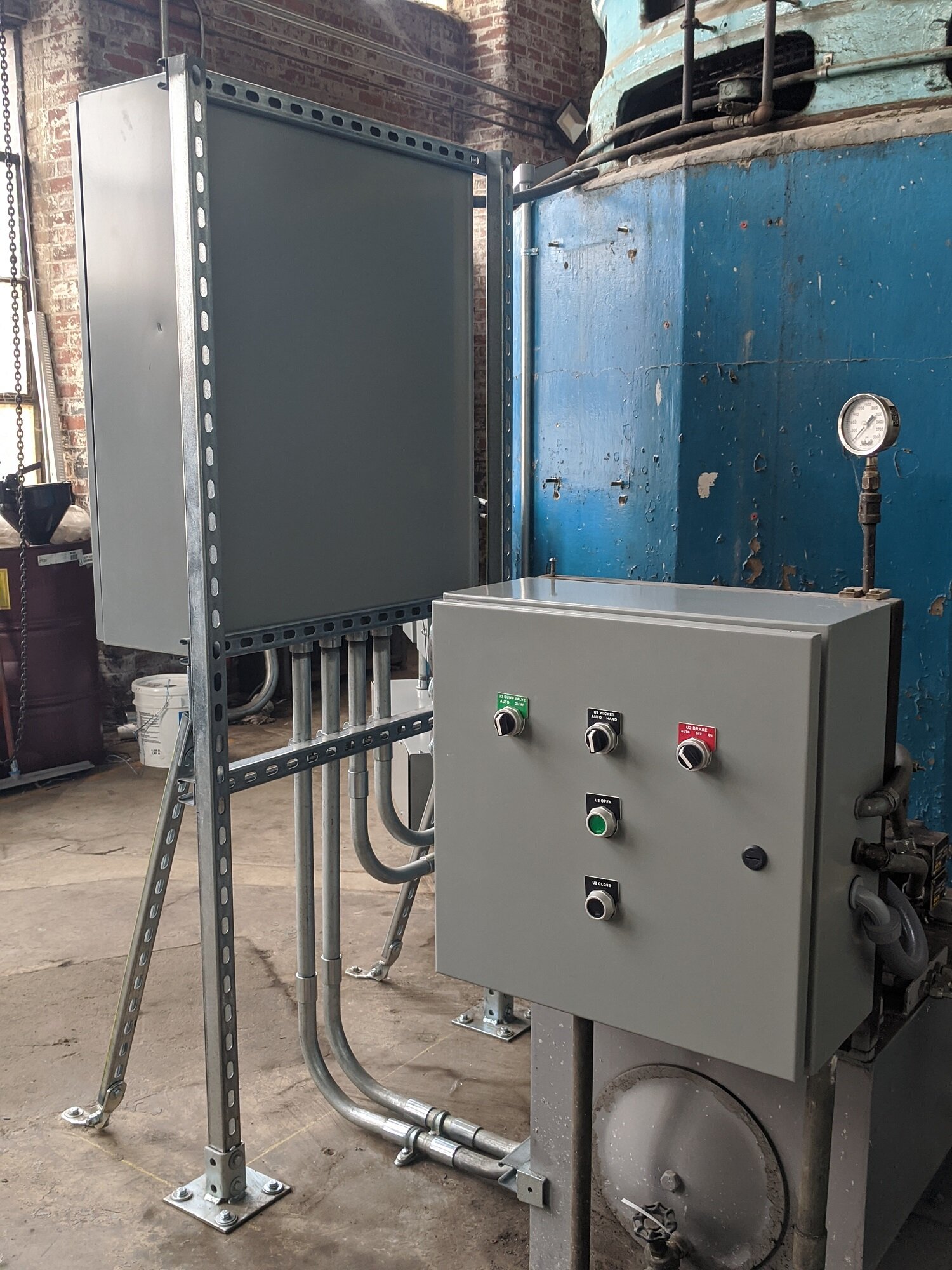PHT Project
1.5 MW, MA
Year: 2020
Running Gear: 3 Vertical shaft Francis turbines with synchronous generators
Scope: Replacement of control system, exciters, and canal gate controller
This is the second controls upgrade project completed for this customer, for another hydroelectric plant on a highly developed river in central MA, with multiple hydro plants operating both upstream and downstream of the project.
Originally constructed in 1905, this project was owned and operated for many years by the local utility, until it was purchased by the current owner in 2017, as part of a sale that included a handful of other plants in the area. The project today consists of a masonry dam and canal gate structure with six water control gates, a 2500 foot long canal through a highly developed former mill complex, forebay, trashrack and intake structure, and a powerhouse with three 500 kW generating units, for a total capacity of 1.5 MW.
The existing controls and switchgear in this plant were a mix of hardware vintages dating back to original construction, and as recent as 2005, and which had become unsupportable and difficult to diagnose and operate. Before the upgrades were completed in 2020, operations required extensive on-site labor time, and plant trips were frequent and difficult to troubleshoot. PHT was selected to provide upgraded controls and replace the excitation system, while another party was hired to provide all new switchgear, station electrical service, and fiber optic lines from the powerhouse to the trash rack and dam. All of the old troublesome control and switchgear equipment was demolished and removed from the upper control level of the powerhouse and replaced with new, modern equipment in 2020.
PHT provided a new control and automation system for the plant, including new Power-Tronics exciters, and additional instrumentation and machine condition monitoring. PHT provided bearing temperature sensors, used existing stator RTDs, added RPM and vibration sensors, oil level sensors, water pressure transducers for the water-lubricated turbine bearings, and many other sensors. PHT provided new control cabinets, and pressure and position sensors for the existing, modern wicket gate HPUs.
At the trashrack, PHT provided a small P1000 PLC to read in water levels, control the new air blast trash rack cleaning system (by others), and to control and monitor the Limitorque-operated sluice gate at the end of the canal. The controls will detect when the rack needs to be cleaned, and then automatically perform the cleaning sequence by turning off the turbines, opening the air valve to release compressed air along the bottom the trash rack, and open the sluice gate to carry away the trash. After cleaning, the sluice gate is closed and the turbines automatically restarted. This has improved plant efficiency, and reduced labor compared to the previous manual rake system.
At the dam, an existing hydraulically-operated canal gate system was fitted with a new PLC, touchscreen and other controls. A Productivity 2000 PLC monitors the headpond and canal levels, and also the positions of each of the 6 canal gates. The controller operates the canal gates as necessary to maintain a correct canal level, and to avoid overtopping during floods. The dam PLC communicates with the main PLC over fiber optic Ethernet, for coordinated operation. In addition to a standard Proportional-Integral canal level control algorithm, this system uses feedforward from the main PLC: When turbines are turned on, the canal gates open immediately to let in more water. When turbines are turned off, the canal gates close partially to prevent the canal level from rising too much.
The new PHT controls now include automatic pond level control, automatic starting, and unit dispatch, better monitoring and reliable protection, push notifications, and remote access. New Power-Tronics exciters replaced old and troublesome static exciters. The existing HPUs and wicket gate operators were reused, with new PHT-supplied position sensors. As is typical, PHT designed and assembled the hardware and control cabinets for this project at our shop in NC, and then traveled to MA for installation and commissioning in 2020. Among other standard features, the new PHT controls provide an easy to use touch screen user interface, remote access that allows monitoring and operation from off-site, and push notifications that allow for more effective operation of the plant. Periodic, automated reports allow both O&M and management staff to better track the plant operation, and to improve plant efficiency and uptime.
(Click on an image for a larger view)











